To Adapt to a Changing Climate, Kyrgyzstan Revives Its Nomadic Past
Aprelude to the growing season, the last week of May usually marks the onset of summer in Kyrgyzstan, a mountainous Central Asian republic about the size of Nebraska. In preparation for the hotter months ahead, flock-owners gather their sheep and shave off their wooly winter fleeces. Farmers and herders make up a third of the country’s labor force, and their seasonal rhythms are essential to the survival of millions of people — and their animals.
But this year, “after the sheep got sheared, the weather changed,” said 42-year-old Taalay Kozhomkulov, who relies on profits from his livestock to support his five children.
On the evening of May 23, an unexpected snowfall hit the pastures of Chon Kemin in northeastern Kyrgyzstan, near the snowcapped range of Tian Shan. The frost killed hundreds of animals overnight, including half of Kozhomkulov’s four hundred sheep.
“It was a big shock. It was bad not only for the animals, but for the whole environment,” Kozhomkulov recalled. A harvest’s worth of fruits and vegetables, growing in the spring sun, also fell victim to freezing temperatures. Kozhomkulov’s stoic outlook belied his family’s heavy losses. “We can’t change the weather,” he said.
But we did change the weather. Kyrgyzstan, a country of only six million people and one of the world’s lowest contributors to global greenhouse gas emissions, has been disproportionately impacted by climate change. And the effects are devastating some of the country’s quietest corners, where human life is still intertwined with — and wholly dependent on — the natural world.
The litany of environmental changes — from desertification and diminishing biodiversity, to natural disasters and erratic bursts of weather — might recall a bleakly familiar narrative in many, if not most, parts of the globe. But they present a unique challenge to a country like Kyrgyzstan, flanked by the Central Asia steppe and the Tian Shan and Pamir mountain ranges and populated only a hundred years ago by nomadic tribes, who left a minimal ecological footprint.
That minimalism was lost for generations. During more than 70 years of Soviet rule, which ended in 1991, the state forcibly organized free-roaming pastoralist clans into collective farms. This meant all but the oldest Kyrgyz remain largely estranged from traditional knowledge systems and animist-influenced attitudes toward nature. Now, faced with a rapidly urbanizing landscape and unseasonable weather bursts, many Kyrgyz are trying to revitalize their nomadic traditions in order to adapt. Their bespoke solutions have emerged as counter-narratives to the discourse on climate change as a global problem, emphasizing the need for local interventions — especially in regions that have been the hardest hit.
“According to some estimations, we are the most landlocked region in the world. That makes us more vulnerable and the impact more pronounced,” said Kanat Sultanaliev, director of the Tian Shan Policy Center, a think tank focused on human rights and sustainable development. “We can’t mitigate it, so we have to adapt to it.”
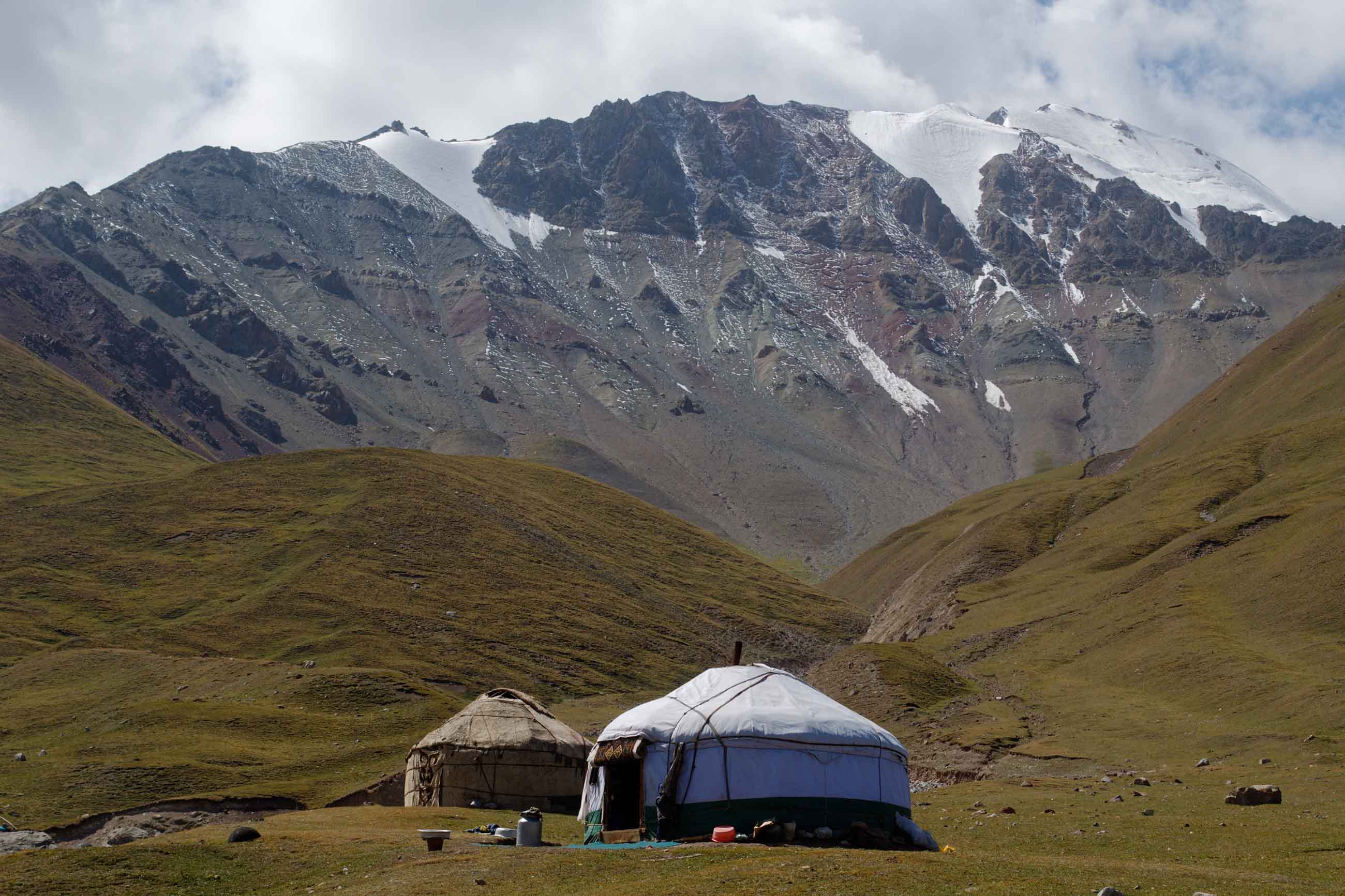
When the Russian Empire formally annexed Kyrgyzstan in 1876, the territory was sparsely populated with few settled communities. Nomadic pastoralist tribes migrated vertically, ascending into higher seasonal pastures during the warmest months, and to lower altitudes in the coolest. They camped in yurts — circular tents fashioned from felted wool — and roamed hundreds of miles with their livestock herds, beyond the borders of present-day Kazakhstan and China. Though the southern Fergana Valley was a hub of Islamic culture, northern tribes mostly followed Tengriism, a shamanist-influenced, Central Asian animist faith that revered the sky and the earth as dual deities, and looked to the natural world for hidden messages from the beyond.
Though there is a danger in romanticizing the nomadic way of life — no doubt harshened by extreme temperatures and rough terrain — it was, from an ecological point of view, more sustainable than most sedentary communities. But in 1917, after the Bolshevik Revolution ended Czarist rule, Kyrgyzstan passed to a new ideological regime. Unlike the direct military campaigns that, for example, characterized French conquests in North Africa, Sovietization was an “intellectual colonization,” said Ruslan Rahimov, an anthropologist at the American University of Central Asia. Traditional clan leaders were derided as bourgeois. Collective farms, powered by husbandry techniques imported from Europe or Russia, supplanted nomadic herding.
Before Soviet rule, Kyrgyz nomads saw nature as “a parent, or as a partner, rather than something they could subordinate,” said Rahimov. But within the sprawling new economy “nomadism was considered backwards, and being nomadic was a shameful practice,” he added. “All property — like yurts, cattle, everything — was confiscated” and “traditional knowledge was almost completely replaced in all fields.”
The region’s practices took a backseat to Soviet prowess. Authorities kept a tight watch on agricultural production and outsourced livestock duties to salaried herders. Kyrgyzstan became one of the largest meat and wool producers in the Soviet Union and the number of sheep in the country grew from three million in 1940 to as many as 10 million by the late 1980s. The state held to firm schedules. “They were very strict about following the timeline of seeding and irrigating and watering,” says Azamat Isakov, director of Camp Alatoo, a Central Asian NGO which focuses on sustainable agriculture.
“After the collapse of the Soviet Union in 1991,” Isakov added, “there was drama.”
Deprived of state oversight and generations removed from traditional techniques, Kyrgyz communities struggled. Water use increased by half while the crop yield plummeted. Even today, 25 years later, a knowledge gap remains — with lasting ecological impact.
“The low yield of crops is 100 percent human[-caused]. You just didn’t follow agriculture techniques. You didn’t seed in time. You didn’t water in time,” said Isakov. “By cutting the trees and over-grazing we’re hastening the process of climate change.”
The impacts of rising temperatures — a 0.13 degree Fahrenheit increase per year in Kyrgyzstan over the last two decades, according to the United Nations Development Program — have intensified thanks to regional activity. Hillsides, stripped of trees for logging and pelted by out-of-season rains, now suffer landslides. The landslide risk is made worse by pasture misuse: Overgrazing livestock have stripped the grasslands, which span 45 percent of the country. Soviet authorities regulated pasture field rotation, but independent herders now stick closer to their villages. And they’ve also lost the nomadic herding patterns: rather than heading up and down the mountains with the season, they mostly bring their flocks to feed along thronged roadsides and venture to the highlands only in summer.
These ecological disasters have also coincided with the disappearance of 20 percent of the glaciers in some areas of the Tian Shan mountain range — nicknamed Central Asia’s “water tower.” In other parts of the world, receding glaciers serve as concerning, but distant shorthand for a planet in peril. In a country with over 5,000 glaciers under threat, it is a frightening everyday reality.
Along with changes to the landscape, weather disruptions — like May’s deadly frost, which took out so many of Kozhomkulov’s naked sheep — have alarmed herders and farmers. There isn’t a way to change the weather back. But traditional ecological knowledge could help communities forestall, or at least foresee, graver threats.
When Karim-Aly Kassam, an environmental and indigenous studies professor at Cornell University, arrived in Central Asia 12 years ago, he wasn’t looking for climate change solutions. But then he began fieldwork in the Pamirs, a mountain range that intersects with the Tian Shan and extends down toward the western Himalayas, and started interviewing locals. The same theme kept coming up. “There was this fundamental anxiety of not being able to anticipate” the changing climate, said Kassam. “The entire socio-cultural system is out of whack with the ecological system.”
In high energy-consuming countries, like the United States, people with the resources to do so have developed instant adaptation strategies: They find comfort in climate-controlled homes or cars, cranking the air conditioning or the heat to soften the blow of unexpected weather. Inside an office or supermarket, a rainy day looks much like a sun-soaked one.
But in Central Asia, adaptation has historically been on a larger timescale, to match seasons. When weather patterns started to change, it threw off these seasonal calendars. “We used to always start cutting grass on the 10th or 15th of August. Now we already start from the 1st,” said Anarbai Harbykov, a 60-year-old farmer living in the village of Kara Kabak, one of Kyrgyzstan’s southernmost settlements in Alai Valley. Once traversed by Silk Road caravans, the border area, near both China and Tajikistan, marks the union of the Tian Shan and Pamir range. Summers in the mountain-flanked region, Harbykov said, have gotten unseasonably chilly.
“The weather is always changing,” he added. “Now it’s colder in summer and warmer in winter.”
As a researcher, Kassam embedded in mountain communities. Soon, he saw an opportunity to revitalize traditional ecological calendars, which, before the industrialization of agriculture ushered in by Soviet rule, delineated time between sowing, sprouting, and harvesting. Now, these calendars exist only “in parts,” he said. That’s changing soon: Kassam is helping to build an ecological calendar, which will launch around 2020. The new calendar, adjusted for climate change, uses regional timekeeping methods, including Silk Road-era systems. Kassam hopes the calendar will help communities track, and ultimately better prepare for, fluctuating weather phenomena.
“Any adaptation strategy has to be grounded in the ecology and the culture where that adaptation strategy is being proposed,” Kassam said. That means recognizing the resources that already exist.
In preparation, Kassam and his team have reanimated another neglected pre-Soviet pastime: Keeping ecological diaries. The researchers have asked residents in the Alai Valley and the Pamirs to add their own detailed observations to the data collected by three on-site climate monitoring stations, which track moisture and temperature levels. “That’s a tradition that they have had,” said Kassam, “and we’ve built upon that.”
Local farmers and herders are already monitoring the landscape. An hour’s uphill drive from the village of Kara Kabak, a dozen yurts sat scattered beyond the looming white rock of an adjacent glacier. Every summer in the “jailoo,” or highland pasture, eight or so herding families spend the grazing season with their flocks. The ecological changes are evident. “Every year we come here, because our fathers did. And our fathers’ fathers,” said 49-year-old Sofia Tashanova. “There used to be little red flowers growing all over the hills,” she added. “But this summer, there were no flowers.”

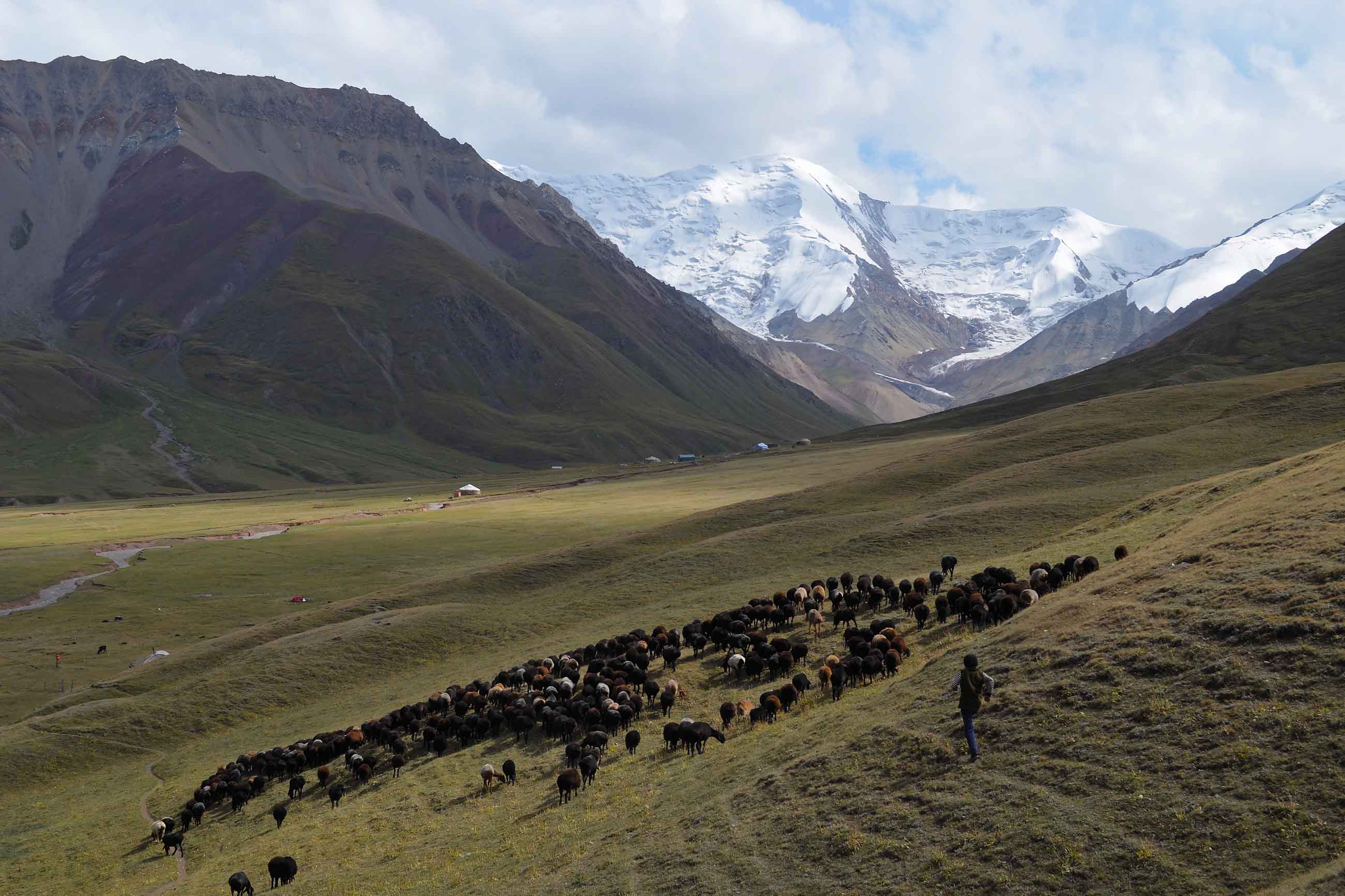
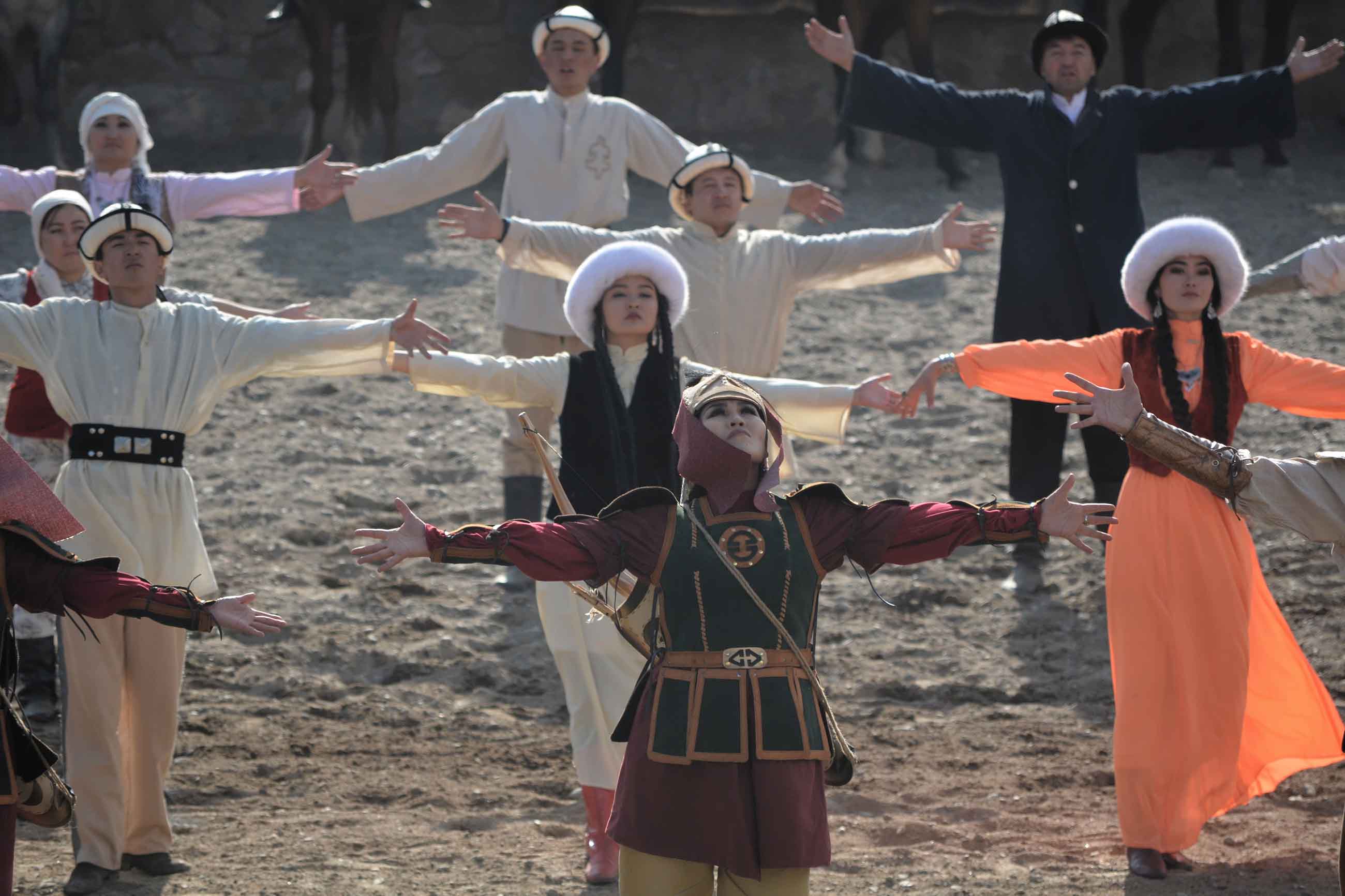
From afar, the pasture is deceptively plush and velvety. But up close, the vegetation is parched and nubby. “This year, grass hasn’t grown much,” said 62-year-old Halnazar Turduev. “I’m already wearing my winter clothes. In the past, I only needed one or two layers.” The shepherd, who was born in the jailoo, remembered thicker fields as a boy: “The lambs would sleep and we couldn’t even see them.”
The recollections and observations, more than just rehabilitating a lost practice, have also acted as context-specific correctives to national climate monitoring stations, which tend to be underfunded and incomplete in scope.
“The [regional] projection models are not relevant to the places we’re working in. Statements like, ‘one degree temperature change,’ or ‘this much rain,’ are not accurate to the context of the valley,” said Kassam. As Kozhomkulov learned with his sheep, rising temperatures might also mean unexpected snow — even at the end of shearing season.
“Context is everything,” Kassam added, and “climate change is arguing just that.”
Local context has also grounded conservation strategies, revitalizing not only practices but also long-discarded cultural attitudes. In the small village of Shabdan, close to the pasture hit by the late spring frost in Chom Kemin, 59-year-old Emil Iymanaliev, a former hunter, now leads a campaign to protect the country’s natural resources. Beyond the forested hills — home to lynx, snow leopards, and the fabled Marco Polo sheep — a low mountain range looms, barren save for a slim halo of ice.
In animist belief, natural signs were powerful harbingers of fortune or doom. Taboos and superstitions stopped people from ravaging nature’s bounty, preventing deforestation or over-hunting. Working with regional NGOs, Iymanaliev invokes the heroes of ancient Kyrgyz epics in his outreach — like Kozhozhash, a mythic hunter whose bloodlust for deer ultimately leads to his own death. “When hunters go through bad luck, I think of the epic,” Iymanaliev said. “Kozhozhash was also cursed by wild goats, same as the villagers.”
The renewed interest in older practices is also part of the broader search for identity that has shadowed post-independence Kyrgyzstan — including not only pre-Soviet, but also pre-Islamic culture. “In all nomadic societies, eco-centrism used to be at the center of our worldview,” said Sultan Sarygulov, a certified beekeeper and director of Bio KG, an agriculture NGO that runs organic farming trainings in Kyrgyz villages. “What we’re doing in these projects is return[ing] to those laws of nature.”
Iymanaliev and Sarygulov are not alone. Aigine, a Bishkek-based research center, catalogues Kyrgyzstan’s sacred geography to reform attitudes toward nature using revived cultural forms. Other groups, like Rural Development Fund, another research center, document traditional grazing methods from village elders, teaching shepherds to assess the health of grass as their nomadic ancestors did. Still others have tried to get herders to migrate their flocks vertically again, away from over-grazed lower pastures and into the high mountains.
“It’s a reaction to processes that seem outside of Kyrgyzstan’s control,” said Amanda Wooden, an environmental studies professor at Bucknell University in Pennsylvania. “People are going to search for alternatives. And people are going to think, ‘Maybe our way worked.’”
Earlier this year, Wooden delivered a talk inside a yurt in verdant Kyrchyn Valley, one of the sites for the World Nomad Games, the bi-yearly event in the province of Issyk-Kul that is part cultural showcase, part competitive sports tournament — and Kyrgyzstan’s ultimate nomadic celebration. Over the course of a week, teams slug it out in traditional pastimes like “kok boru,” the Central Asian version of polo, which uses a goat carcass in lieu of a ball. Hundreds of performers take part in dance-filled, nostalgia-fueled shows, like the pyrotechnic “Golden Age of Nomads.” This year, a symbol of the games — dubbed the Nomad Olympics — was not an Olympic torch but a blue, ornately decorated jar of glacial meltwater.
Ariel Sophia Bardi is a Delhi-based writer, academic, and journalist, whose work has appeared in The Atlantic, Slate, The Guardian, and BBC, among other publications.






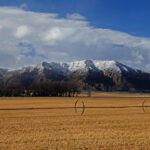



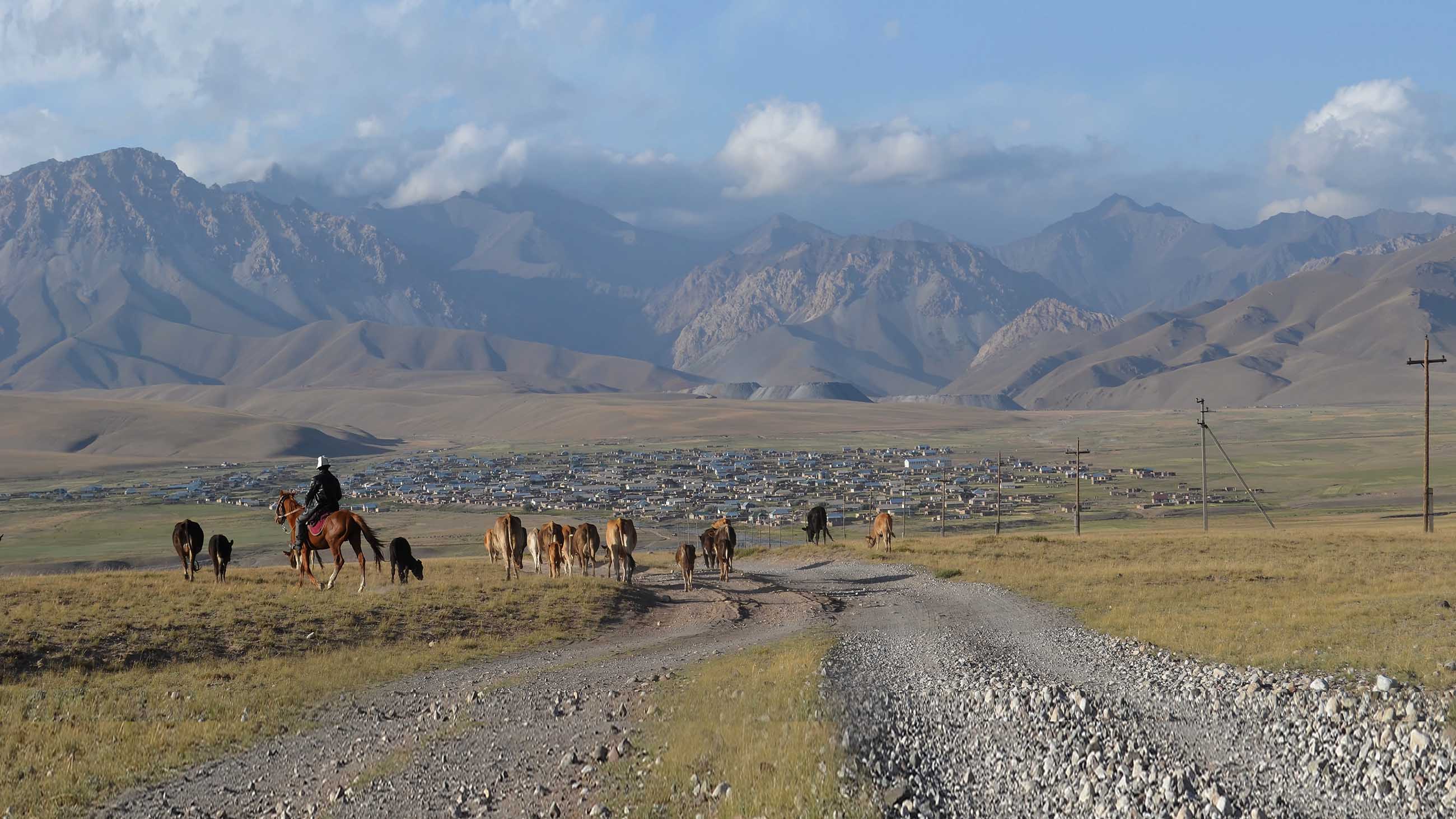
Comments are automatically closed one year after article publication. Archived comments are below.
In reply to Lynn Morgan.
The Tian Shan are more locally known as Tenggri Tagh, in severl languages meaning “Great Sky Mountain[s]”
The peoples of high Asia understand, contrary to the English writers with cognitions damaged by theri mideast tripartite religion, that the Great Sky has no limited sexual or gender orientation, but covers all.
the “Animists” who, according to the European or Euroamerican writer, infer inaccurately the signals of biotic organisms and weather DO have a complete and accurate perception of biotic and physical earth. The fact that they naturally share our evolved sense of compassion, pity, awe, love, relationship, with what seem to the dissociated to be inanimate, somehow exempt from the mortality from which we evolved this essential neurological and emotional sense (long before ever becoming modern humans in shape. The parts of brains that involve awareness, evaluation, and especially immediate emotional response, occur in vertebrates at least as distant as fishes) some individuals may not at all understand the coherence and ecologically reflective worldview, being analogous to “fundamentalists” instead of understanding the actual worldview of the “shamanistic.”
Shaman is an Evenk word, appropriated by western religionists todistort the actual “job” of those individuals who have apprenticed and specialised in recognizing environmental signaling, including the social signaling of all animals, and the responses of plants – which are known by science to hormonally and electrically occur, albeit more slowly than through neuronal structures.
Because they are also in effect and practice, community psychologists – I had grave disagreement with my grad psych mentor as I described to the culture-bound professor that ecological recognition that all variations of life have a validity equal to our own, and as I studied this worldview and its decreasing syncretism as one moves north across the continent from India and china, it was also clear that this intimacy was being lost, to the detriment of entire species and systems, not to mention the less-important human species and its cultures.
Those “animists” more realistically recognize that humans are not by an immense gulf, any “crown of creation”, but merely becoming an aberrant infectious disease. Shamans, Olmen, have the job of bringing us back into line with the others, as any will tell you.
Behavior, the discipline of ethologists, neuroscientists, and other more limited disciplines, is slowly being mapped, and humans are less, rather than more, attuned to the signals of variation that move their own social groupings, than are other animals, although we are completely capable of [e]learning this complex usage of our brains, now enamoured of dead and toxic technologies and solipsistic yet vacuously depressing focus upon ourselves only, all else inaccurately imagined as “property.”
But important to the article, it was about the late 1950s that Soviets under Khrushchev, had decided that the vast grassland steppes north and east of the Caspian into Mongolia and Siberia, were “better” used as another Ukraine or US Great Plains. They began those vast groundwater-dessicating projects and dewatering of Amu and Sur Darya, and other rivers leading from their part of the great central Asian mountain arc. It was brush desert they created and left behind.
The SAME process occurred in Chinese Mao’s destruction of Inner Mongolia, and now, perhaps worse spatially, the Chinese intend to dam and transport water of the Northand northeast Himalaya to the Taklamakan and possibly Gobi, dewatering all of southeast Asia.
Mongolia had long urbanized, injecting Teng-gri with the toxic elements of coal burning, sulphur and mercury, detectable in the atmosphere of the US west.
Antelope and original wild ovids and capridae, once lived in those similarly fertilizing nomadic herds as the plains bison and pronghorn, who covered North America from Alberta east of the Rockies into Mexico’s Sierra Madre valleys, including the devastated Rio Brazos plain from Houston to Galveston.
Human domestication, and consequent killing of the interadapted wolf, from Manchuria to its new and final safe haven in the Pripyat/Chernoby Ukraine remnant, along with this agriculturalization which nearly emptied the massive Aral Sea, and more damagingly groundwater everywhere it has been perpetrated, has laid barren more and more earth, the soils being blown and eroded away.
This last was the world’s worst ecological damage before the rising temperatures of anthropogenic global heating was known to the scientific consensus by the late 1980s.
Ancient tales I helped gather , told of the animals becoming worried about the fact that humans had no way to speak with them, nor with the Great Sky itself, and sending communications to those greedy and unthinking humans (so-called “communism” you have all now found, is as exploitative and dissociated as capitalism).
The dead and gone central Asian sea, the scrub desert supplanting vast grasslands, the catastrophic diminution of many large and other species, not to mention aquifers, water tables, within a human lifetime, were signals – sent by that Great Sky – the atmosphere itself, intimately tied to the underground roots of all things that “shamans” visit in their cognitive exploratory journeys.
No matter what language you explore in high Asia, you will find that the names all tend to reflect that association with Great Sky, one of the three worlds. The lost and butchered trees mentioned are known to the natural peoples as the only beings that live in all three worlds.
Dissociation indeed.
Eco centric ! Thats what is lost. All the climate change deniers AND all those like myself who fought her whole life to get folk to wake up to climate change, the crux of it all is the loss to the human psyche of our attachment to the land. Swapping this Great Goddess with the god of materialism causes much unhappiness. Which ever side of the fence you sit we need connection to the land.
The concept of man made climate change is the biggest swindle in human history. Climate has always changed but human activity has nothing to do with it.
Kathy Voth-we do operate in a different system but as I was reading this piece, it made me think about the regional/seasonal “migration” grazers could employ to adapt to changing weather outside the arbitrary fenced borders of our individual farms/ranches. (While keeping a grazing chart like the mentioned diaries)
Articolo molto bello.
wonderful original reporting.
Uh oh! The word “sustainable” is a trigger. Fits right in with Agenda 21, so if you’re not part of the Big Plan that’s not a great choice of words.
The story seems to end in mid-sentence. Could you check for us and add the rest if there is more?
This is a really great article and I would like to share it with my farmer and rancher readers at OnPasture.com. Though they operate in a completely different system, I think it’s helpful to see examples of how others solve problems with raising livestock.
Sorry, Kathy. Apparently a technical glitch on our end. We’re investigating and will restore the missing part. Thanks for bringing it to our attention. -Tom
Thanks for your comments. I’d be very interested to hear more about what you’re planning. Feel free to get in touch by email!
This is great reporting. I believe that this sort of story can communicate the idea that we are already suffering from net damages caused by climate change and that it is not something that will happen in a far off future. I posted this to my Facebook feed as well.
Splendid and important article. We published 4 Editions of our Odyssey guide to Kyrgyzstan. Our next one will be to “Sustainable Kyrgyzstan” I do hope we can collaborate.
Sincerely,
magnus (Bartlett)
Publisher.